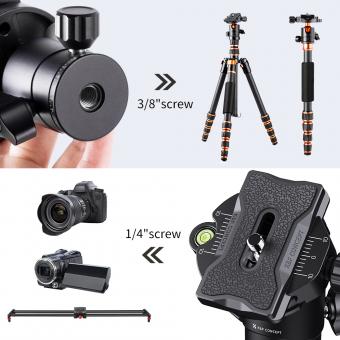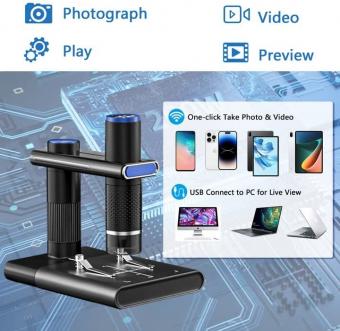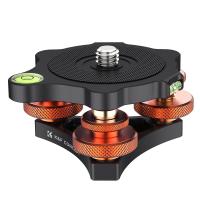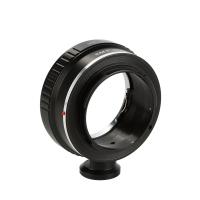Are Digital Microscopes Any Good ?
Digital microscopes can be a valuable tool for various applications. They offer the advantage of capturing and displaying images directly on a computer or other digital device, allowing for easy sharing and analysis. The quality of digital microscopes can vary depending on the specific model and brand. Higher-end digital microscopes often provide high-resolution images and advanced features such as zoom capabilities and image processing. However, it is important to consider the intended use and requirements when evaluating the suitability of a digital microscope. Factors such as magnification power, image quality, software compatibility, and ease of use should be taken into account. Overall, digital microscopes can be a useful option for many scientific, educational, and industrial purposes.
1、 Resolution and Magnification
Digital microscopes can be a valuable tool in various scientific and educational settings. They offer several advantages over traditional optical microscopes, such as the ability to capture and store images and videos, easy sharing and analysis of data, and the ability to view samples on a computer screen.
One important aspect to consider when evaluating the quality of digital microscopes is their resolution and magnification capabilities. Resolution refers to the level of detail that can be observed, while magnification refers to the ability to enlarge the image of the sample.
In recent years, digital microscope technology has advanced significantly, leading to improved resolution and magnification capabilities. High-resolution digital cameras and advanced imaging software allow for the capture of detailed images with excellent clarity. Some digital microscopes even offer features like autofocus and image stitching, which further enhance the quality of the images.
However, it is important to note that the resolution and magnification of digital microscopes can vary depending on the specific model and brand. It is crucial to carefully evaluate the specifications and reviews of different digital microscopes before making a purchase.
Overall, digital microscopes can be highly effective tools for scientific research, education, and various other applications. They offer convenience, versatility, and the ability to capture and analyze images and videos. With the continuous advancements in technology, digital microscopes are becoming increasingly powerful and capable of providing high-resolution images and accurate magnification.

2、 Image Quality and Clarity
Digital microscopes have become increasingly popular in recent years due to their convenience and versatility. When it comes to image quality and clarity, digital microscopes can indeed be quite good, especially with advancements in technology.
One of the main advantages of digital microscopes is their ability to capture high-resolution images and videos. With the use of high-quality sensors and advanced optics, digital microscopes can produce clear and detailed images of microscopic specimens. This allows for better observation and analysis of the samples, making them suitable for various applications such as research, education, and quality control.
Furthermore, digital microscopes often come with built-in features that enhance image quality. These can include adjustable lighting, image stabilization, and autofocus capabilities. These features help to improve the clarity and sharpness of the images, making it easier to identify and study the microscopic details.
In recent years, there have been significant advancements in digital microscope technology. For example, some models now offer higher magnification levels, allowing for even closer examination of specimens. Additionally, there have been improvements in image processing algorithms, resulting in better color accuracy and reduced noise in the images.
However, it is important to note that the image quality and clarity of digital microscopes can vary depending on the specific model and brand. It is advisable to do thorough research and read reviews before purchasing a digital microscope to ensure that it meets your specific requirements.
Overall, digital microscopes can provide excellent image quality and clarity, especially with the latest advancements in technology. They offer a convenient and efficient way to observe and analyze microscopic specimens, making them a valuable tool in various fields.

3、 Versatility and Compatibility
Digital microscopes have become increasingly popular in recent years due to their versatility and compatibility with modern technology. These microscopes offer a range of benefits that make them a valuable tool in various fields, including research, education, and industry.
One of the key advantages of digital microscopes is their versatility. Unlike traditional microscopes, which are limited to viewing samples through eyepieces, digital microscopes allow users to capture and store high-resolution images and videos of their samples. This feature is particularly useful in research and education, as it enables easy sharing and analysis of data. Additionally, digital microscopes often come with built-in measurement tools, allowing for accurate and precise measurements of samples.
Another advantage of digital microscopes is their compatibility with modern technology. Many digital microscopes can be connected to computers, tablets, or smartphones, allowing for real-time viewing and analysis of samples. This compatibility also enables remote collaboration, as researchers and educators can easily share their findings with colleagues or students located in different locations. Furthermore, digital microscopes often come with software that offers advanced image processing and analysis capabilities, enhancing the overall functionality and usefulness of the microscope.
In terms of the latest point of view, digital microscopes continue to improve in terms of image quality, resolution, and ease of use. Manufacturers are constantly developing new features and technologies to enhance the capabilities of digital microscopes. For example, some models now offer 3D imaging capabilities, allowing for a more comprehensive understanding of samples. Additionally, advancements in artificial intelligence and machine learning are being integrated into digital microscopes, enabling automated analysis and identification of samples.
In conclusion, digital microscopes are indeed good due to their versatility and compatibility with modern technology. They offer a range of benefits, including the ability to capture and store high-resolution images, easy sharing and analysis of data, and compatibility with computers and other devices. With ongoing advancements in technology, digital microscopes are likely to continue improving and remain a valuable tool in various fields.

4、 Ergonomics and User-Friendliness
Digital microscopes have become increasingly popular in recent years due to their numerous advantages over traditional optical microscopes. When it comes to ergonomics and user-friendliness, digital microscopes offer several benefits that make them a good choice for many users.
One of the main advantages of digital microscopes is their ergonomic design. Unlike traditional microscopes, which often require users to hunch over and strain their necks and backs, digital microscopes can be easily adjusted to a comfortable viewing position. Many models come with adjustable stands or articulating arms, allowing users to position the microscope at the optimal height and angle for their individual needs. This ergonomic design helps reduce the risk of musculoskeletal injuries and promotes long-term comfort during extended use.
In terms of user-friendliness, digital microscopes offer several features that make them easy to use and navigate. Most digital microscopes come with built-in cameras and LCD screens, eliminating the need for additional equipment or complex setups. Users can simply view the magnified images directly on the screen, making it easier to observe and analyze samples. Additionally, digital microscopes often have intuitive controls and user-friendly interfaces, allowing users to adjust settings, capture images, and record videos with ease.
The latest point of view on digital microscopes emphasizes their continuous improvement in ergonomics and user-friendliness. Manufacturers are constantly working to enhance the design and functionality of digital microscopes, taking into account user feedback and technological advancements. For example, some models now offer wireless connectivity, allowing users to control and view microscope images from their smartphones or tablets. This added convenience further enhances the user experience and expands the possibilities for collaboration and remote work.
In conclusion, digital microscopes are indeed good in terms of ergonomics and user-friendliness. Their ergonomic design and adjustable features promote comfort and reduce the risk of strain or injury. Additionally, their user-friendly interfaces and intuitive controls make them accessible to users of all levels of expertise. With continuous advancements in technology, digital microscopes are becoming even more user-friendly, offering additional features and connectivity options to enhance the overall user experience.







































